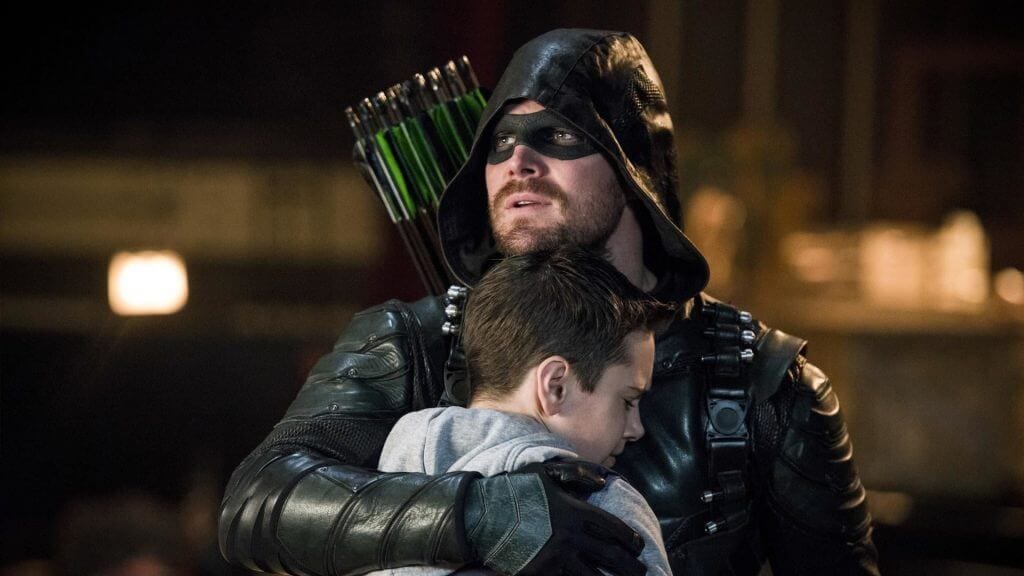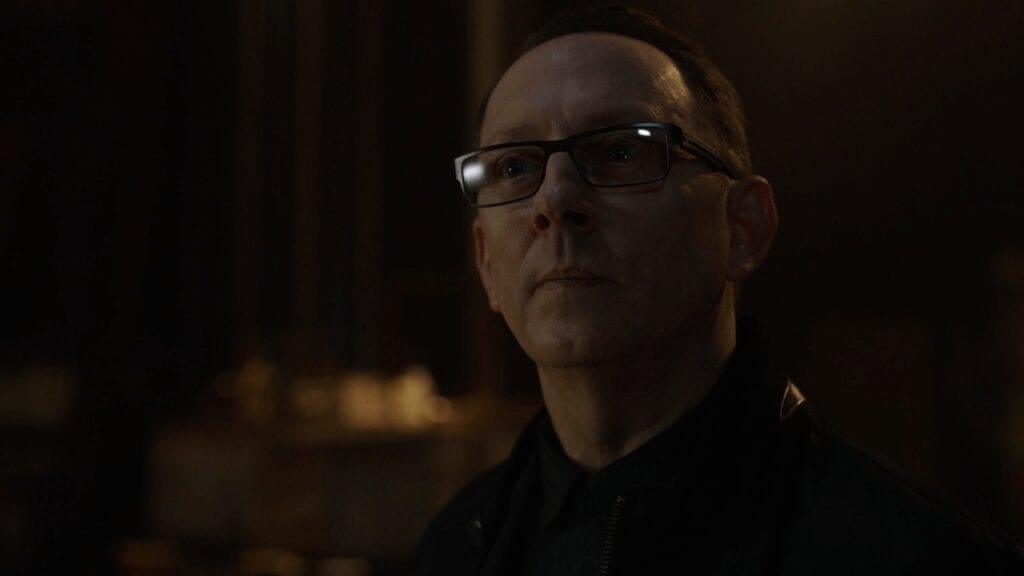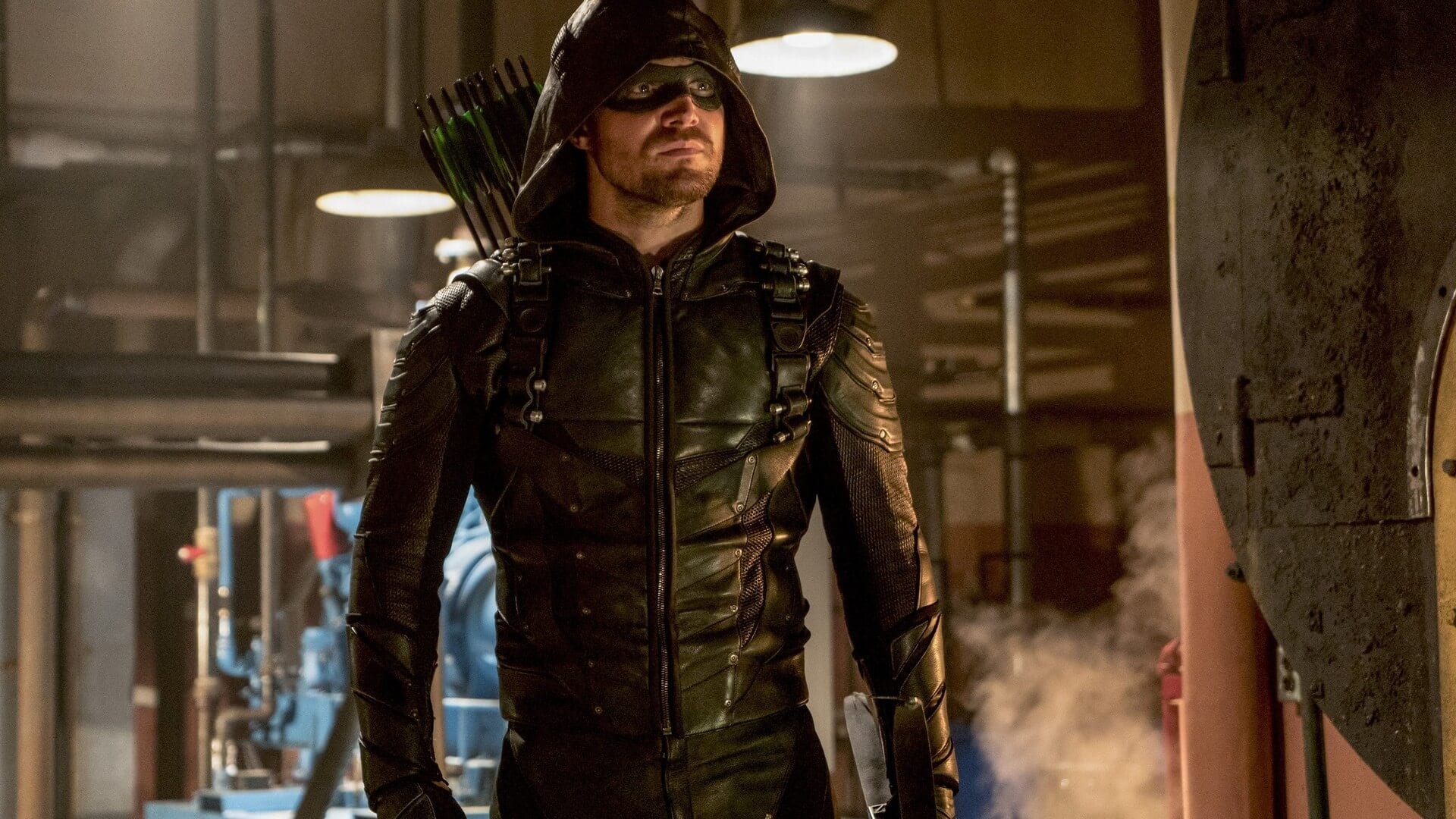REVIEW: Arrow Season 6 (2017-2018)
Arrow season 6 is like a Hot Pocket; parts are hot, parts are cold, and you alternately enjoy it and curse it for not cooking evenly. Certain elements of the new season are handled very well, with a character who’d lost her way of late acting like her old self again, another becoming a much more compelling version of herself, and a new and exciting villain setup to plague Star City. On the other hand, they drop the ball with the bad guys, retread old plotlines (and not particularly good ones) and make us sit through constant whiny lectures from the Team Arrow members I prefer to call the Little Rascals.
*Spoilers for Arrow Season 6*
The first episode of Arrow season 6 picks up immediately where season 5 ended, with Lian Yu exploding after Prometheus’ suicide. The “who died?” cliffhanger that had been hanging over us all summer is quickly squandered when the only character who doesn’t make it is Samantha, mother of Oliver’s son William. Arrow really has a penchant for taking any opportunity to pare down its unwieldy cast and growing it instead. (Remember when Laurel died and guilted Oliver into bringing on three people even more annoying than she was?) Not only is no one on the team dead, but now Oliver has to raise William – because what every dark superhero action show needs is a kid who won’t do his homework. Fortunately, this turns out much better than expected; William is a fine addition to the show, never overstaying his welcome and bringing out new facets of Oliver while allowing him to be the Green Arrow (for the most part). I still would have preferred if they’d killed a few useless stragglers on the team, but it could’ve been much worse.

Said stragglers have been a nuisance since they showed up, but they really drag down Arrow season 6. Curtis is a male Felicity with none of her charm, something these Berlanti DC shows keep doing (see proto-Ray Palmer Nate on Legends of Tomorrow); Rene is an obnoxious faux tough guy whose constant taunts aren’t nearly as endearing as the show seems to think they are; Dinah (get it, comics fans!?) is bland and condescending, taking on all of her Black Canary predecessor’s worse traits instead of becoming something new and interesting; all three are judgmental hypocrites who castigate Oliver for not trusting them while proving themselves completely untrustworthy. This is something else Arrow has done in its later years; while early on the supporting characters called Oliver on his legitimate mistakes, he’s now picked apart for every single thing he does, even when he’s right. It was annoying enough when Felicity did it, but it’s intolerable coming from these nobodies. Their breaking off from Team Arrow is good in that it gives the main three a reprieve from their entitled pettiness, but of course the end of the season brings them all back together again. I always figured it was naïve to hope for anything different, but it doesn’t look like the Little Rascals are going anywhere.
Thankfully, most of the people we actually like fair pretty well in Arrow Season 6. Oliver continues to grow, as a man and a hero. Where once he was afraid of letting anyone get too close to him while being a vigilante, he’s now – after a mercifully short retirement – ready to embrace both having a family and fighting crime as the Green Arrow, and the show explores this through his marriage to Felicity and his raising William. His struggles at being a father are handled quite well, and they feel specific to Oliver rather than the typical “Isn’t Dad dumb?” subplot; his response to William’s school suspension over a fight with a bully is perfect and exactly what Oliver Queen would do in that situation. William’s presence also accentuates the compatibility of two people as different as Oliver and Felicity; Felicity can help with homework and comfort him when he’s scared, while Oliver can prepare him for the world and keep him safe from the evil that will forever threaten them. On top of that, the family unit makes Felicity more of a partner for Oliver than the nagging girlfriend she’d become; she’s supportive of him, and even sticks up for him on occasion (who knew this was even possible anymore?), but will still tell him when she thinks he’s wrong. In short, the Felicity Smoak we fell in love with is back, and not a moment too soon.

Diggle is served well in Arrow season 6 too, with his dedication to Oliver and drive to hold the team together explored. After the explosion on Lian Yu, he’s got nerve damage that prevents him from operating to his full potential as a vigilante. This is bad enough when he’s Spartan, but when Oliver asks him to take over as the Green Arrow it’s disastrous. Diggle is now in an impossible situation, because he either admits that he is incapable of honoring his best friend’s request or tries and inevitably fails. It isn’t that Digg is proud; it’s that he so respects Oliver he can’t face the thought of letting him down. When the rift with the Little Rascals occurs, Diggle becomes the sort of go-between, trying to maintain his role as the team’s conscience and keep them as together as possible, but slowly realizes that this, too, is not in the cards. Season 6 is about John Diggle understanding that having good intentions only takes you so far – something Oliver had to learn long ago.
Outside the big three, Arrow season 6 is generous with two of its other mainstays and stingy with the one who seems to always get the shaft. Quentin Lance has a worthwhile storyline at long last, in his attempts to reform Earth-2 Laurel. While everyone else sees a monster wearing their friend’s face when they look at Black Siren, Quentin sees the possibility of resurrecting his daughter, and he defies every last one of them to do it, believing till the end that his Laurel is in there somewhere. His death is a big loss for the show, but it’s beautiful that he gives his life so that his little girl can live again. Laurel herself is much more interesting and likable as her interdimensional doppelganger. This Laurel is caught between good and evil, struggling with the weight of her actions and the faith of the one good man who still believes in her. I’m glad the show went this route, and I look forward to seeing her develop even further now that Quentin is no longer around to support her. Thea, conversely, is barely present and has nothing much to do while she is, much like last season; she briefly gets hunted by former League of Assassins members and swoons over a returning Roy Harper, and that’s about it. It’s grating that Arrow consistently sidelines characters we’ve followed since the beginning to shove newbies like the Little Rascals down our throats.

Speaking of sidelining great characters to make way for lesser ones, the trajectory of the villain dynamic in Arrow season 6 is a tragedy. Arrow has had a good track record of delivering something new and interesting with each big bad, and Cayden James is no exception. Oliver can fight another martial arts master, but what can he do to a computer hacker even more skilled than Felicity? James recruiting a bevy of Oliver’s peripheral villains – Black Siren, Vigilante and Anatoly Knyazev, with newcomer Ricardo Diaz – and waging war on the Green Arrow and Star City is a great setup that again separates him from previous bad guys. What a shame, then, that the wonderful threat they’d built is summarily discarded at the midseason break to give rise to Diaz, who kills James and takes over as the main heavy. Where James was a different kind of enemy that forced Oliver outside his comfort zone, Diaz is just a gangster punk who never feels like the threat he’s supposed to be. He’s reminiscent of some of the mini-bosses from earlier seasons, like Brick or Tobias Church (both of whom were better characters). Instead of fearing for his life, we’re left wondering why Oliver doesn’t just put Diaz down with a well-placed arrow. It doesn’t help that James is played by Michael Emerson at his creepy best, unnerving even while physically weak; Kirk Acevedo, who plays Diaz, just can’t compare. And the finale doesn’t even offer a satisfying comeuppance for him; Diaz yet lives, ready to take up more screen time better spent with another villain. Swell.
The subplots are a mixed bag as well. Arrow season 6 sees the return of “I am the Green Arrow no more!” which is something I wish superhero entertainment would just retire already. I know this tired cliché will never die, but do we really have to do it over and over again in the same show? We know Oliver is coming back, and we’ve seen him learn the work/life balance lesson before; why beat around the bush over and over? The FBI investigation fares better for the most part, though Agent Watson – the face of the crusade to unmask and jail Oliver – disappears for the bulk of the season, only to turn up again at the very end. But in the meantime, it causes Oliver serious trouble and leads to a great episode called “Docket No. 11-19-41-73,” where he’s literally put on trial for being the Green Arrow. Both of these stories converge in the finale, when Oliver reveals himself as the Green Arrow and goes to prison in exchange for the FBI’s help in stopping Diaz, retiring so Diggle can take his place (AGAIN!). I’m starting to feel like these DC/CW shows could benefit from shorter seasons; maybe they’d be less inclined to repeat the same storylines ad nauseam.

Luckily, Arrow can still be counted on for the best action sequences on (network) TV. Seemingly every episode has inventive, exceptionally well-filmed superhero fights, shootouts and chases, and the camera and stunt work is breathtaking. Each season improves on its predecessor in this area, and in Arrow season 6 there are long, winding takes reminiscent of the final battle in The Avengers where we follow multiple combatants through a large, frantic war zone, dropping one only to pick up another. The sets are nothing special, but Arrow certainly makes the most of them. Particular highlights are the Green Arrow rolling off a scaffold as he tussles with a bad guy and the camera never cuts, and Deathstroke’s much-heralded return as he guns down the henchmen of a mysterious master criminal who turns out to be his son. It’s rare to see a movie these days with as much energy and deftness of movement as any given episode of Arrow.
And so another chapter in Oliver Queen’s saga is in the books. Arrow season 6 has a lot going for it, but almost as much weighing it down. While some of the main characters are treated well, Thea gets the short end of the stick again and the show’s obsession with the third-tier vigilantes continues, with no end in sight. The subplots are messy and a great villain is replaced halfway through by a chump Oliver should be able to pulverize in the space of a single episode, but the action is still incredible and a formerly irritating regular is thoroughly rehabilitated. If Arrow would cut its seasons down by half or so and lose the Little Rascals, it could once again attain the heights of its first couple of seasons, but since neither of those things will ever happen, season 7 will likely be another Hot Pocket.
Arrow Season 6
Plot - 6.7
Acting - 6.9
Progression - 7.7
Production Design - 6.8
Action - 9
7.4
Okay
Arrow season 6 has a lot going for it, but almost as much weighing it down. While some of the main characters are treated well, Thea gets the short end of the stick again and the show’s obsession with the third-tier vigilantes continues, with no end in sight. The subplots are messy and a great villain is replaced halfway through by a chump Oliver should be able to pulverize in the space of a single episode, but the action is still incredible and a formerly irritating regular is thoroughly rehabilitated.







